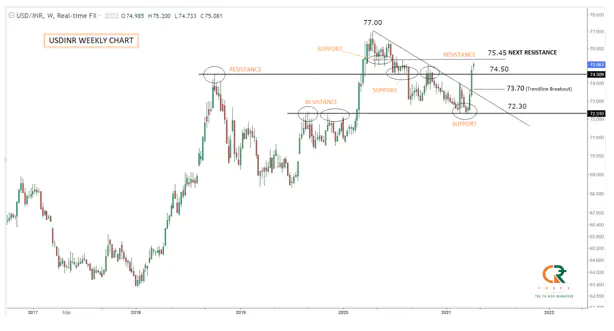- April 13, 2021
- Posted by: Amit Pabari
- Category: Currency

India is a land of “Unity in diversity”. In the recent past, it has been observed that Rupee has opened lower post-long festival holidays. After a long weekend followed by Holi in late March, Rupee was seen opening lower by 33 paise at 72.84. Then, after first-four day holiday in the new Financial Year, Rupee opened lower by another 32 paise at 73.42. And now we have a two-day banking holiday due to many festivals and occasions. Currently, the NDF Rupee is trading at 75.45 levels, lower by another 38 paise than yesterday’s closing. The traders must be analysing the global market and Rupee’s move but not able to take a call on it. Meanwhile, we just want to catch your attention to some interesting matter which will turn your call towards either the 77 or 73-mark.
The below factors will help you to analyze the impact of the fundamentals and technical on Rupee and able to judge the view.
RBI’s another round of QE and its impact on bond
Between the two options of “Hawkish” and “Hold”, the RBI selected a third option called “Dovish” by announcing further liquidity in the system to support the government’s borrowing cost. The resultant of this was seen discounting in the benchmark 10-year yield to trade near 6 percent. The reason could be pre-attempting on increasing Covid cases and its likely impact on the growth. The market had started pricing in future RBI rate hikes. But they surprised with a plan of Rs 25 lakh crore bond purchases on 15th April and a total INR 1 lakh crore this quarter. Further, it will confirm that the fiscal targets are likely to be hit sooner than later and could shake up the value of the Rupee.
Double whammy effect of higher US dollar and weakening domestic fundamentals
The prospects of growth in the US recovered after the announcement of Biden’s double stimulus package, better-than-expected vaccine rollout and upbeat economic data. However, Fed wanted to remain behind the curve and letting the market to price in future hikes. But definitely, Fed will have to follow the market path and come up with a hawkish tone. On the domestic front, rising inflationary pressure (5.52 percent in March) and weakening industrial output data (-3.6 percent) could slow down domestic growth. The double whammy impact of the rising US dollar and weakening domestic fundamentals could translate into a depressed Rupee.
Inverted volatility curve signals RED light for Rupee
Over the past many instances, it has been observed that whenever the volatility curve has been inverted (Short term volatility is higher than long-term), the Rupee depreciates heavily. This time, 1-month volatility is trading higher at 6.61 percent and 3-month volatility is trading at 6.53 percent – suggests inverted yield curve. The spike in short-term volatility will have unwanted movement in the Rupee.
Technical chart with breakout
The given USDINR weekly chart seems very interesting as momentum is tracking “support” and “resistance” closely. When USDINR started falling from 77 in April-2020, the pair took support near the previous resistance of 74.50 levels and then fell to 73 after consolidating a bit. Recently, we have seen that 72.30-40 acted as strong support which was double strong resistance during 2019. Post bottoming out last month, the pair has given a breakout from down trendline at 73.70 and jumped strongly above the 74.50-mark without hesitation. Moving forward, the pair could find resistance near 75.20 a bit and further at 75.45 levels. Crossing of this zone will open the door towards another technical confluence level of 76.20 and further towards ATH (All-Time High) of 77. On the contrary side, a breakout level of 73.70 will act as strong support over the medium term.
Conclusion:
With the recent bout of weakening domestic activity due to rising COVID cases, shortage of vaccine, RBI’s further dovish move will negate excess return from the risk-on trade in India. The fall in interest rate differential between EM & US, rising fiscal deficit, global commodity-linked inflationary pressure could lead to a flight of capital back to safe-haven investments like the US dollar and treasuries. Overall, this could pressure on the Rupee up to 76.20 and further till 77.00. The depreciating pace could slow down a bit on RBI’s regular intervention but will have not to option other than letting it weaken in case of contagion effect of “zero fear” like March-2020.
Strategy for Exporters:
Thin Margin: Thin margin exporters having new orders are suggested to participate on every uptick towards 75.45 levels for costing around 74.00-74.20 levels. Overall, advise maintaining an 80-100 percent hedge ratio.
Thick Margin: Other exporters having new orders are advised to participate between 75.20-75.45 zone and wait for the further higher move with the stop loss of 74.50. Overall, they advise maintaining a 45-50 percent hedge ratio. Here, we suggest not to go beyond 50 percent till it shows of a reversal signal.
Strategy for Importers: Importers are suggested to be in sync with RBI’s intervention move. Any correction by 25-30 paise from high will be the opportunity to cover and keep recent high as stop loss. They are advised to follow a defined hedge ratio with a minimum coverage of 30-45 days. For more than 45 days of coverage, we advise covering fresh orders on back to back basis to avoid uncertainty on new exposure.
-Amit Pabari is managing director of CR Forex Advisors. The views expressed are personal.
Leave a Reply
You must be logged in to post a comment.


